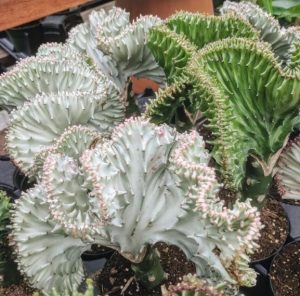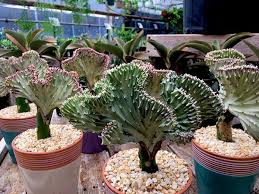If you are a plant lover, then you probably have a few succulents in your home for decorative purposes. But none of them can compare to a coral succulent. While the coral cactus is usually ignored as a house plant, it is a good house plant option on account of its unique look.
If you are new to ‘plant parenthood,’ then you are probably wondering about caring for a coral cactus. This unique plant is pretty low maintenance. Keep reading to learn how to care for a young coral cactus plant.
The coral cactus is not a type of cactus and is probably one of the hardiest household plants you can get. It can grow in USDA zones 10-11. It only grows to a maximum height of roughly 25-inches.
Coral Cactus Care Tips
First and foremost, your coral cactus plant needs to be planted in gritty soil that drains fast. When you buy the plant, pot it in a mix of potting soil and sand in the ratio 1:1. You can also use cactus potting soil. Only cover the roots in the soil. Covering the stem in the soil will cause it to rot.
Place the plant in a warm place with indirect sunlight. The ideal temperature range for this plant is 60-70 degrees Fahrenheit.
Water the plant immediately you pot it. Avoid overwatering the plant to prevent the roots from rotting.
To check the soil water level, use your finger, then determine whether you should water the plant or not.
You can fertilize the cactus on occasion with diluted fertilizer at least once in spring and summer. Use a balanced 10-10-10 liquid fertilizer diluted at quarter strength.
Do not use a ceramic pot as it retains moisture, which is not ideal for the coral cactus. For added nutrition, add organic matter to the potting mix. Place the plant in a shaded area during hot summer months to avoid sun damages.
Pests and Diseases
Here are the main problems to look out for when tending to your coral cactus;
Secondary Stem
If your coral cactus starts to grow new stem near the primary crown, you can prune it near the crest. Alternatively, you can leave it and have a unique looking coral cactus.
 Pest Infestation
Pest Infestation
Use a cotton swab dipped in diluted rubbing alcohol to remove any bugs or insects on the plants. You can also use diluted neem oil to remove spider mites. You can also try to spray the insects with water to eject the insects and or bugs.
Powdery Film
This is an indication of mildew growth and is a result of limited air circulation. To treat the plant, apply a solution of baking soda diluted in water. Use one tablespoon of baking soda in 4litres of water.
Coral Cactus Brown Spots
Brown spots on your coral cactus can be a sign of a fungal infection, water damage, or scalding from extreme temperatures. If arrested early, you can save the plant by watering it right, using the right antifungal, and pruning the damaged sections.
What Causes Coral Cactus Brown Spots?
While the most common cause of brown spots is rotting leaves from a grafting infection or overwatering, other things could make your beloved cacti develop those dreaded brown spots.
Water Damage after Overwatering
In most cases, brown spots are a reflection of root damage caused by overwatering. Even though the spots won’t go away, you can stop the spread by reining in your watering efforts. Remember that cactus is an arid area plant so it doesn’t need so much water to survive. You should only be watering if the potting mix is dry for a centimeter or two below the surface.
Ensure that your planter or pot has a drain hole at the bottom to prevent water from gathering at the bottom. If you have pebbles covering the surface, ensure that you move them to the side before assessing if your plant needs more water. Inspect the wetness of the actual potting mix before decided to water your coral cactus again.
Extreme Temperatures
Coral cactus is prone to freeze damage. If the plant is in contact with a cold window or close to an air conditioning vent, it could be affected leading to brown spots. Your plant might also get a sunscald if it is in direct sunlight.
Move the plant away from the window or the air conditioner vent to avoid further damage.
Fungal Infection
Fungi is the other possible culprit for brown spots on your coral cactus. Fungi thrive in high humidity low light settings. Your plant will be susceptible if you are overwatering it in the first place. If your apartment or house is dark, consider using some grow lights or moving the plant to a well-lit place to discourage fungus.
Normal fungal infections can also be treated using common fungicides especially those with a percentage of copper.
However, if your coral cactus catches Anthracnose, a fungal infection spread by Colletotrichum fungus, you will need extra measures. Small light brown spots that grow into orange or red spore masses characterize the infection. If you see this, move your plant to an isolated space, cut back on watering and apply neem oil for a couple of weeks until the infection goes away.
Why is My Coral Cactus Dying?
Coral cactus, like most succulents, is a hardy plant. However, it will dry up if you are not taking good care of it. Here are the top reasons why your beloved coral cactus is drying up.
Overwatering
This can cause your plant roots to rot, which in turn can cause your plant to die.
Bad Potting Mix
A poor potting mix can cause the soil to drain poorly, which will cause the roots to rot.
Plant Infection
A plant may get infected during grafting or pruning. It can also happen when a part of the stem breaks off. The open wound can also become a perfect munching target by insects. This can lead to the death of the plant.
Pot Size
A small pot will choke the plant’s roots and curb its growth. On the other hand, an excessively large pot will lead to overhydration of the pants roots causing them to rot.
How Do You Save a Rotting Coral Cactus?
If the rot is on the leaves and stem, you can prune the coral cactus and remove all the rotting sections. However, if the roots of the cactus have begun rotting, then it may be too late. And you may not be able to save the plant. To void this problem altogether, you can reduce the number of times you water the pant.
How Much Light Does a Coral Cactus Need?
On overage, 3-5 hours of sunlight will be enough to sustain the pants. Rotate the plant on occasion to ensure it gets sunlight on all sides. Failure to do so may cause the plant to grow unevenly. Or cause the exposed plant side to grow towards the sun. If you don’t have direct access to the sun, a good grow light can make things better.
How to Tell if a Cactus is Over or Under Watered
An overwatered cactus will be soggy and mushy. The top signs of overwatering to look out for are:
- Stem and leaves turning brown or black
- The base of the cactus turning brown or black
- A mushy and leaky cactus
- The plant looks as if it is rotting
On the other hand, if the plant begins to wilt or droop, then the plant is under-watered.

How Much Water Does a Coral Cactus Need?
This depends on the season and the size of the plant. Your cactus will need more water during the spring and summer months and less water during the colder winter and fall months. Only water the plant if the soil at the top of the plant is dry.
A rule of the thumb is to water when the soil feels dry an inch below the surface. Other than this physical check, you can resort to watering once a week or fortnightly during spring and summer. Reduce the frequency to once a month during autumn and winter.
It is best to water the coral cactus from the bottom and avoid watering the plant directly. Pour the soil onto the soil until it is fully saturated and begins to overflow.
The coral cactus produces a thick white latex sap that is toxic. It may cause skin irritation when touched. Always wear gloves to avoid getting contact dermatitis from the sap. It can also cause nausea and vomiting if ingested. To avoid any potential accidents, place the plant at a height that is unreachable to kids and pets.

 Pest Infestation
Pest Infestation